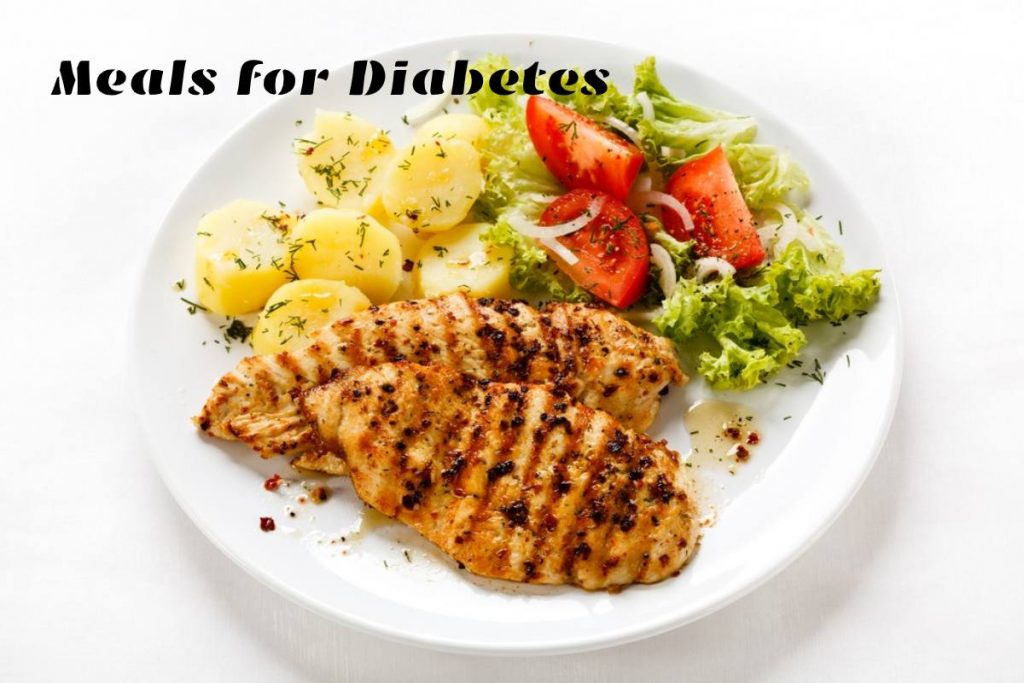Table of Contents
Introduction
meals for Diabetes?- The quality of foods eaten by a person with diabetes during the day plays an essential role in maintaining blood sugar, as carbohydrate consistency should be supported by eating the same amount at breakfast, lunch, and dinner to keep blood sugar from rising or falling sharply.
Forty-five grams of carbohydrates are also recommended as a target for the three main meals per day.
So if they are less than 30 grams per meal, it won’t be easy to get all the nutrients you need, such as fiber, phytochemicals, which are health-enhancing nutrients in fruits and vegetables.
The typical meal plan provides 1,400 calories a day, where healthy snacks can be eaten between essential meals to reach the calories appropriate to your diet. Through the way, people with diabetes make healthy and proper meals.
Learn About Meals and How Meals Work For Diabetics
Breakfast
If you’re in a hurry in the morning because of work, make breakfast quick and rich in fast and varied items, such as:
Boiled eggs.
Nuts, seeds.
A piece of skimmed cheese or peanut butter.
Yogurt for protein.
Toast, crispy bread, or unsalted instant oatmeal.
Any fruit, such as bananas, apples, dried fruits.
For example, you can make a mashed avocado toast sandwich, eggs, and a little salt and pepper, if it’s an easy-to-prepare meal rich in fiber and carbohydrates, as one sandwich supplies the body with about 235 calories.
Lunch
Continuing to eat a whole wheat toast sandwich may be an easy way to control carbohydrates if eating small pieces of brown bread with a salad or soup full of protein and vegetables is a good choice for lunch.
Such as chicken soup with vegetables and nuts, supplying the body with approximately 433 calories.
Snacks
Be sure to snack between the main meals to fill your hunger and are usually a light fruit or salad.
Dinner
Make sure you are rich in vegetables and a small amount of wheat bread, such as:
One Example of Meals for Diabetics
Here’s how to make chicken tortilla soup, an example of healthy meals for people with diabetes:
Ingredients
One tablespoon olive oil.
Medium onion.
A green pepper, diced.
Four cloves garlic, chopped.
Half a kilogram of skinless chicken breasts.
One tablespoon chili powder.
Two teaspoons of cumin.
Half a teaspoon salt.
Tomato paste.
1 cup chopped coriander.
Here are the Preparation Steps in the Following
Take the oil in a saucepan, heat it over medium flame, add onions, peppers, and garlic and cook until softened.
Add chicken breasts, chili powder, cumin, salt, and heat until all ingredients are covered with spices.
Add tomatoes, chili, broth, and hot water and simmer for 20 minutes or until the chicken is fully cooked.
Remove the chicken breasts into a plate until cool enough to withstand them.
Use a blender to mash part of the soup in the meantime.
Cut the chicken using a fork and return it to the pot and leave for another 20 minutes.
Divide the tortilla slices, avocado, and cheese into a serving dish and roll the soup over it, garnish with lemon and coriander.
Per serving of this meal: 466 calories.
Top Tips to Follow When Doing Meals for People with Diabetes
One of the essential tips to follow when following the way meals work for people with diabetes is:
be sure to drink drinks without added sugar.
Choose foods with high-fiber carbohydrates, such as oats, legumes, brown bread, milk, and sugar-free milk.
Reduce eating red meat, and make sure you get protein from healthy foods, such as fish, unsalted nuts, eggs, chicken, turkeys, etc.
Eat lots of fruits and vegetables.
Choose fat-free cheeses and dairy.
Choose healthy snacks, such as unsalted nuts, fruit instead of biscuits and chips.
Stay away from drinking alcohol.
Be sure to include healthy meats in your diets, such as avocados, olive oil, and fish.
Be sure to get vitamins and minerals from food instead of supplement pills.
Reduce salt intake.
Foods to Avoid When doing Meals for Diabetics
There are some foods that a person with diabetes should avoid, including:
Trans fats, such as peanut butter, fast foods, and ovaries.
White bread, rice, pasta.
Drinks with extra sugar, such as coffee and local tea.
Fruit-flavored yogurt.
Flavored coffee drinks.
Honey, biscuits, pancakes.
Dried fruit.
Salty crackers.
Packaged snacks, such as pastries and biscuits.


